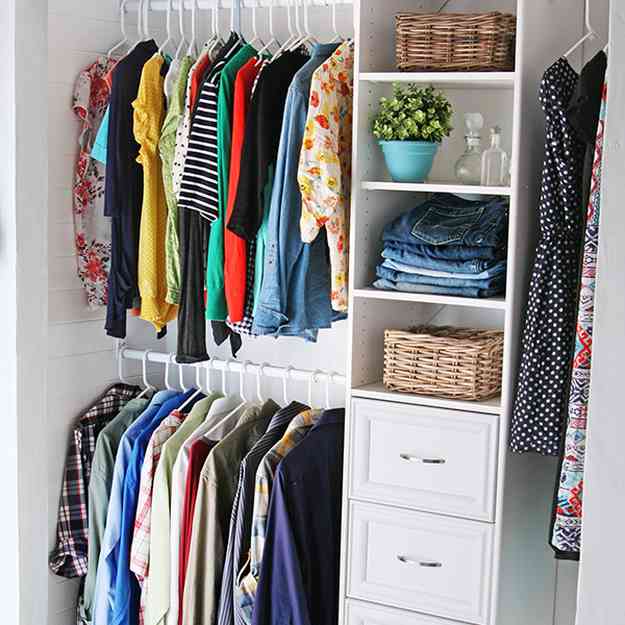Spring time has officially arrived in New York’s Hudson Valley and with it an overwhelming urge to – say it with me ladies and gents – ORGANIZE! Although there are several reasons the changing of the seasons is the perfect time for cleaning and reorganizing, perhaps the most obvious is that it is usually the time we are packing away seasonal items we no longer need. This gives us the opportunity to be the most honest with ourselves about what we did and did not use over the past year and to act accordingly.
If you are reading this and feel like we couldn’t possibly understand the hoarder-esque quality that you feel your closet has achieved – we assure you we’ve seen it all. Hang in there and read on! While we do not offer professional organization services in our business, we have been around the organizational block more than a time or two in the last 20 years and have aimed to create a resource of our most useful tips, tricks, and wisdom in this guide that will be sure to assist in tackling even the most difficult of closet cases.
First, begin with a strategy
Too often closet space becomes a dumping ground for things we do not intend to “live” there permanently. The old adage out of sight out of mind. We’ve all done it – guests are coming for a surprise visit, and suddenly all the mail you’ve been meaning to sort through goes from your coffee table to a dark corner of your bedroom closet. We will get to the paper organization in another post perhaps, but for now imagine how at ease you will feel the next time that same situation arises and you have designated places for all your belongings. Our favorite house cleaning “truth” also applies to home organization – it is much easier to maintain a good maintenance system over a long period of time than it is to let everything go, and then try to get it all back to order in the ten minutes before you have company. Having dedicated places for all of your things will help you achieve this organizational nirvana. This is why your strategy will be important. You will want to begin by asking yourself a few very basic questions; “What type of closet is this?” and “What do I want to store here?”
What Type Of Closet Is This?
There are 3 basic types of closets every person has in their home, the largest and most desired being the walk in closet which as the name suggests is a closet deep enough for a person to walk into. The second largest but most common are called reach in closets. Reach in closets are named for their convenience and relatively shallow depth, everything is accessible within arms reach. Then we have usually the smallest closet option which are wardrobes/armoires. Assessing how much storage potential your closet has will be key to knowing how you want to proceed reorganizing.
What Do I Want to Store Here?
In an ideal world, every closet in your home would have a specific purpose. For instance many people have coat closets near their home’s entry, some have entire closet spaces dedicated to just linens or just cleaning supplies, pantries are technically really just food closets, and almost everyone has a closet to store their clothing in. While this is the ideal situation if you have the space, realistically we understand that we do not live in an ideal world and many of us just do not have the luxury of tons of closet space to work with. When this happens you may need to be a little forgiving with your system and plan for your closet to function as dual storage spaces, for example storing cleaning supplies together with your linens. We would urge you to consider that not all storage solutions need to be Pinterest worthy – they just need to work for you and your family. Focus on a functional, maintainable system. For the purpose of continuity in the remainder of this post we will be assuming we are reorganizing a typical clothing closet, but regardless of type of items going in the closet these steps will remain the same.

1. Pull Everything Out of Your Closet
The first step to the actual reorganization of your closet is to remove all of the items from the closet. Although it may be hard, taking everything out and visually assessing all your items is the best way to begin. You never know what is hidden in there until you take everything out.
2. Identify and Decide
Identify what you want to keep and what is no longer useful. We encourage you to get your children involved in this step, not only does it set a good example, but is it a good life skill for them to learn how to organize themselves. Even young children can help with the simple task of sorting through clothing items. An easy way to determine what still has value to you is to ask yourself a few basic questions:
- Is the item in good condition? This one is pretty obvious but if you’re holding on to an old hole-y pair of sneakers that have seen better days, it’s time to let them go.
- Would I buy this again? If the answer is no, don’t put it back in your closet! Trends come and go and sometimes even a new item just hasn’t lived up to it’s expectation. Leave these items out.
- Have I used this in over a year? If again the answer is no, the item is probably not necessary and just taking up valuable closet real estate.
- Is this a seasonal item? Just because an item is seasonal we aren’t suggesting you throw it away, but it may be the best idea if you have limited closet space to separate these items and put them into storage until they will be useful again.
The second part of this is to then use your decisions about what is useful to make three piles. In one pile you will have the clothes that you still want to keep and will put back in your closet, the second pile are clothes you want to put in seasonal storage, and the third pile is for any clothes you would want to throw away or donate.
3. Organize your piles
Once you have gone through the entire contents of your closet, focus on your toss/donate pile first, from this separate out things that are in good condition and throw away items not fit for donation. Some great local donation options are:
Next consider appropriate options for your seasonal/storage pile. Many times bulky sweaters, coats, even blankets can benefit from vacuum sealing. Not only is this option space saving, but it protects your items from dust, dirt, moisture, mice and moths. Now on to the fun part!
4. Reorganize with a strategy!
Organizing your remaining items by color can look very nice, but in reality it is very hard to maintain your closet when it is organized by color. A system that is difficult to maintain will ultimately set you up for failure. This is when you start going through your whole closet and end up leaving it unorganized. To prevent this from happening, organization by category. By working with a system that will work for you, you will be able to find what you need and increase the likelihood your organizational system will stick.
Don’t put everything back before having a plan of what the easiest way to maintain your closet organized would be.Here are some tips:
- Most used items: Must be at eye level in your closet
- Least used items: You can either put them at the end of your closet rack or up high.
- Use boxes or a hanging organizer to sort shoes!
- Use shelf dividers to organize a variety of clothing pieces
5. Don’t Give Up!
The best thing about creating your own organizational system is that it is a living system that grows and changes with your family’s needs, and you are free to adapt and change it as needed. Despite your best efforts, do the kids keep leaving their coats on the floor? Maybe install lower hooks that are easily accessible to them. We encourage you to be creative in your pursuit of organization! Happy cleaning!


